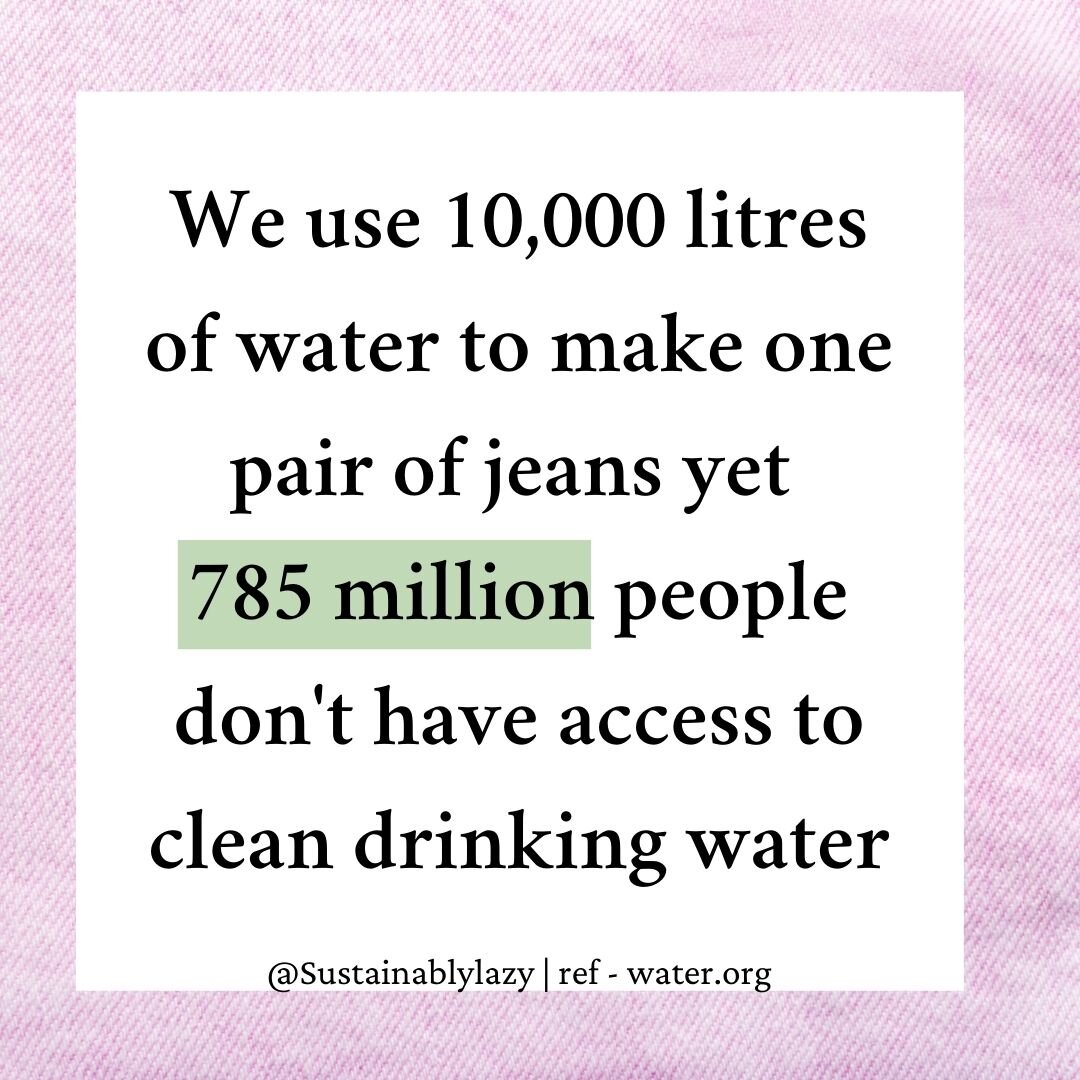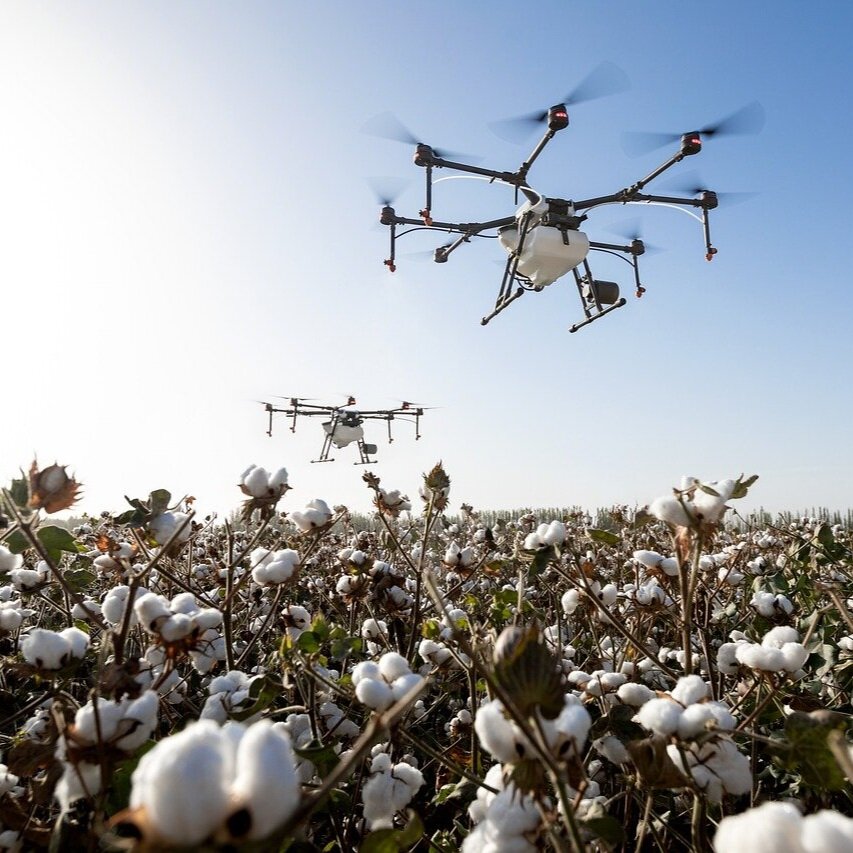How Does Fast Fashion Impact The Environment?
“Fast fashion’s closet is overflowing with skeletons and people don’t want to be a part of it anymore.”
10,000 litres.
That’s how much water it takes to make a single pair of jeans.
When you consider that 2.1 billion people don’t have access to safe drinking water, it seems ridiculous that the fashion industry creates 80 billion new items of clothing every year.
Decades of overproducing clothing in an unsustainable way have given fast fashion a catastrophic environmental impact. From polluting the air and water with dangerous chemicals to filling the oceans with microplastics, fashion needs to change its ways and fast.
Public polling from Hubbub in 2019 has revealed that 50% of women under 24 buy new clothes every month to keep up with the latest styles, and 1 in 6 won’t wear the same outfit again if it’s been seen on Instagram.
Thankfully, the public is starting to realise what’s happening behind the scenes.
Trends and disposable clothing are getting replaced with second-hand shopping. Consumers are embracing their own personal style.
As long as garment workers are trapped in poverty and forced labour, the sustainable fashion movement isn’t done.
It is clear more awareness needs to be raised, so let’s get stuck into fashion’s dirty secrets, shall we?
In this post:
What is the meaning of the term ‘fast fashion?’
How much clothing ends up going to landfills?
What happens to unsold clothing?
How does fast fashion contribute to climate change?
Why does fast fashion waste so much water?
What’s the link between cotton and climate change?
Is cotton sprayed with pesticides?
What chemicals are used in textiles?
Water pollution from textile factories - a human rights violation
Why are microfibers an issue?
How are microplastics affecting wildlife?
Tap to pin this to your sustainable fashion board on Pinterest:
1. What is the meaning of the term fast fashion?
Fashion is ‘fast’ because it’s shifted from 4 seasons a year to a new collection each week (or more).
Keeping up with the latest trends set weekly by celebrities and paid influencers has become the ‘normal’ thing to do, with consumers quickly feeling like their clothes are out of style.
For corporations to keep selling large amounts of cheap clothing and still make a big profit, they have to outsource the manufacturing to developing countries where the minimum wage is unethically low and workers’ rights are not protected.
While a small number of white billionaires (mainly male) grow richer every day from our shopping habits, millions of people of colour (mainly women) live in extreme poverty and struggle to feed their children.
Fast fashion brands have successfully made disposable clothing normal. The poor-quality garments produced are not made to last resulting in higher levels of consumption and excessive waste.
In order to make an important contribution to solving the problem of fast fashion, you can check Jooble for jobs in the sustainable fashion industry.
2. How much clothing ends up going to landfill?
The charity WRAP estimates UK consumers throw £140 million worth of clothing in the bin each year. This is a serious problem because over 60% of clothes are made out of synthetic materials, which are created using petroleum-based fibres.
Basically, if you go and have a look through your wardrobe you’ll probably find most of the clothes are made from plastic.
Plastic microfibers take 100s of years to break down and once they do, tiny particles of plastic remain that pollute the soil.
The BBC also reported that garments returned online have to be processed differently. The amount of returns is increasing every year and companies do not have the tech in place to deal with high quantities of products. Therefore, more than half end up in a landfill or incinerators.
Returns also have a negative effect on the environment because of the transport required to ship them to different locations.
3. What happens to unsold clothing?
After Burberry admitted they’d incinerated £28.6million worth of unsold clothes, the BBC asked 35 brands about what they do with the clothes they can’t sell and only 6 actually replied.
Their secrecy speaks volumes.
H&M has been accused of burning clothes multiple times, but denies all the allegations, saying that the only clothes they incinerate are defective or do not meet safety regulations due to chemicals or mould. Yet in 2018, one of their reports revealed a $4.3 billion stockpile of deadstock.
You may be wondering why fashion brands would incinerate stock good enough to wear. Only a third of the 150 billion items produced annually is sold at full price and another third is discounted. Many brands feel that if they applied further reductions to the third of clothes that go unsold it would hurt their brand’s image.
Instead, they may choose to set fire to unsold inventory for a small profit. This works because waste can be incinerated and turned into energy.
While incineration is a better option than landfills, it still produces carbon dioxide and other greenhouse gases which contribute to climate change. It’s also an insult to the human beings that work hard to create these garments.
Fast fashion brands need to stop producing high quantities of clothing and change to a circular economy (not a recycling one). This will only work if they stop encouraging overconsumption.
4. How does fashion contribute to climate change?
Growing the cotton, dying the yarn, sewing the buttons… nobody really knows how many places your shirt has travelled to before it arrived in your wardrobe. Fast fashion has a long, untraceable supply chain.
Their obsession with producing huge quantities of clothing all year round and shipping it to different countries for different stages of production means the industry’s carbon footprint is catastrophic. Their greed is destroying the planet as we know it.
Fashion contributes approximately 8% of carbon emissions (although there are conflicting reports and statistics on this number ranging from 4-10%). The industry uses more energy than planes and ships combined thanks to its intensive manufacturing, which seems extreme until you remember fashion dips its toes into many industries.
Synthetic materials, like polyester, acrylic, and nylon, are made from crude oil, a fossil fuel that pollutes the oceans, causes oil spills, and releases toxic greenhouse gases into the atmosphere. Fossil fuels are the number one contributor to climate change.
All the different environmental issues I cover in this article overlap in some way, and there is more on climate change in section 6.
Making fashion corporations responsible for their environmental impact would make such a difference, but unfortunately, MPs voted against that idea in 2019 when they rejected 15 motions.
Download and share these on Instagram:
5. Why does fast fashion waste so much water?
Cotton is a thirsty bugger. Not only does the garment industry waste clothing and energy, but it also wastes an unacceptable amount of water.
I mentioned earlier that it takes 10,000 litres of water to make a pair of jeans… think how long it would take you to drink that. I struggle to drink 2 litres in a day!
Despite this, there are millions of people in developing countries that grow cotton or live near textile factories (which I cover in section 10) without access to clean water. Desert conditions with irrigated water are the best conditions to grow cotton, but people living in desert areas need that water.
DID YOU KNOW: Globally, 785 million people don’t have access to clean drinking water.
Yet fashion marketing has brainwashed many of us into thinking it’s uncool to repeat the same outfit. We are mass-producing clothing at an alarming rate, stealing a vital resource that we’re too privileged to understand is precious.
Photo credit - Ruivalesousa [a boat graveyard where the Aral Sea used to lie before cotton farming caused catastrophic environmental damage]
Ruivalesousa - The Aral Sea
6. What’s the link between cotton farming and climate change?
What’s really shocking is that the 4th largest lake in the world, the Aral Sea in Uzbekistan, has almost dried up. Since cotton farms started using their water for irrigation, the water level has dropped 23 metres.
The Aral Sea created a natural balance in the region and since its disappearance, the temperature has increased causing nearby mountain glaciers to melt.
The salt from the lake has caused the soil to erode leaving clouds of carcinogenic dust (made from salt and pesticides) causing throat cancer and lung disease in nearby villages.
What was once a thriving lake and fishing community is now a contributor to climate change and a serious health hazard to the local people - it’s heart-breaking.
Unfortunately, Uzbekistan is still a major producer of cotton and climate change is only the beginning of the issue. Slave labour is a government-controlled operation in Uzbekistan with over a million people forced to pick cotton against their will. It is a massive violation of human rights. Millions of people not only live in fear but are exposed to dangerous chemicals with no access to clean drinking water. Find out more here.
Prassanapix - spraying cotton fields with pesticides without ppe
7. Is cotton sprayed with pesticides?
If you’re afraid of insects, cotton farming would be your worst nightmare. It’s a crop that several types of bugs love resulting in it being sprayed intensively with more pesticides than any other crop. Not so natural after all, is it?
Pesticides are bad for the environment because they damage the soil, the wildlife, and pollute the air and water. Not to mention the health risks to the farmers who have to breathe them in all the time.
Certain carcinogenic pesticides are known to kill bees and other insects that pollinate our food. You can buy these toxic insecticides in Wilkos and garden centres in the UK so I’d hate to learn what is used in countries with fewer restrictions than the EU. This is a serious matter because a 2019 study revealed that 40% of insect species are in decline.
Organic farming is much safer, you can find out more about it here.
Image by Cengizkarakus - dying silk
Image by GCShutter - vibrant dye
8. What chemicals are used in textiles?
Mercury and Lead are used in the dyeing of blue jeans.
Clothes are dipped in formaldehyde to stop them from getting wrinkled in shipment. Formaldehyde is a “probable human carcinogen” so if factory workers don’t have protective clothing they will be more likely to develop nasal cancers. It is recommended to wash new clothes before you wear them, especially if you have skin conditions like eczema.
Highly toxic flame retardants (although the EU has banned the worst ones, it’s still impossible to know what has been used).
The pesticides and insecticides used in cotton - 389 different types are allowed in the EU for conventional cotton farming, some of these are carcinogenic and toxic to the reproductive system. You can see a chart here.
Phthalates (hormone-disrupting chemicals) are in anything plastic such as shoes and accessories.
It’s not just your standard high street or online clothing brands either, it’s outdoor clothing, designer clothing and children’s wear too. For more information on chemicals check out Greenpeace’s Detox campaign.
Image by Yuelan - polluted water waste from a factory going into a river
Image by Meen_Na - dead fish in a chemical filled river in Thailand
9. Water pollution from textile factories - a human rights violation
DID YOU KNOW: 20% of all freshwater pollution comes from textile factories [source].
I struggle to stay calm when I think of the devastation that fashion factories cause to the environment and local peoples’ human rights. The main reason for this is that they are doing it on purpose.
During production, fabrics are washed multiple times creating wastewater that needs to be disposed of afterwards. Factories could dispose of wastewater responsibly, but they don’t. They dump it illegally and release dangerous chemicals into the water.
As part of a study in India, soil and groundwater was tested near textile factories. The results found a variety of heavy metals, like lead, mercury and cadmium in amounts that were labelled unsafe by the World Health Organisation.
This extreme level of pollution is impairing the quality of life for many people living in India, including children, who have to bathe and wash their clothes in it. This report by Changing Markets talks about the challenges local people face in finding safe water to drink.
Not only do nearby communities not have access to clean drinking water, but they are also at high risk for diseases like cancer, birth defects, infertility, skin allergies, tuberculosis and stomach disorders.
Once you fully understand the extent of the damage this industry is causing, you realise why transparency is such an issue.
Image by duble-d - microplastics on a beach
Image by dotted hippo - microplastics in the sea
10. Why are microfibers an issue?
Synthetic clothing, like polyester, acrylic and nylon, is made out of plastic.
When an item of synthetic clothing gets washed, it releases tiny thread-shaped particles of plastic into the water system, known as microfibers.
There is estimated to be trillions of plastic particles in the ocean, 35% of them are coming from our clothes.
This is because millions of microfibers may shed in every wash and because our water treatment plants can’t filter them out, they end up in the ocean. This means they are in the rain, the tap water we drink, and the fish that we eat.
There isn’t enough science to tell us if ingesting plastic will cause health issues to humans, but the tests done on sea creatures and birds is not good.
11. How are microplastics effecting wildlife?
A study examined the animals that washed up on Britain’s shore and found every creature had microplastics in their gut.
Lab results have found small creatures, like plankton, that are food for many fish and sea creatures are harmed by microplastics, affecting their ability to reproduce and eat.
A few different studies on crabs, zooplankton and crustaceans noticed they were feeding much less, possibly because their gut was filled with plastic. Unfortunately, this leads to poor nutrition, low energy levels, deformity and health problems in many of the lab tests.
The big issue with microfibers is that chemicals in the water are drawn to them. We’ve already covered the chemical cocktail the fashion industry have polluted the water with. It’s also worth considering that although the EU has banned a lot of dangerous chemicals, they are not banned in all countries, like America, and are still pose a threat to water and air.
When fish ingest particles of plastic that have absorbed carcinogens from the water it can be fatal or cause other health problems like liver toxicity.
Although we know we are eating and drinking microfibers, humans and animals are very different and there isn’t any research to say it will cause us health problems.
Tap to pin this to your ethical fashion board on Pinterest:
Educating yourself and becoming a conscious consumer is the next step for anyone who’s new to sustainable fashion.
You can still be passionate about style and go shopping regularly, but it’s kinder to the planet if you swap fast fashion for second-hand shopping. Depop is great if you don’t live near thrift stores.
What do you think is the worst issue in the fashion industry?
If you found this post informative, please tap the share button below. As a work at home mum who is boycotting Amazon and avoiding annoying pop-up ads (the usual ways to make money from your website), every share means the world to me. You can also support my content by buying me a coffee or following me on Instagram. Thanks for being here - Sophie <3













![Photo credit - Ruivalesousa [a boat graveyard where the Aral Sea used to lie before cotton farming caused catastrophic environmental damage]](https://images.squarespace-cdn.com/content/v1/5bb8cd5aa09a7e4c80cb9fd8/1617180456582-JANYDT0N0VYX19PO9KS7/aral+sea+-+cotton+farming+impact.+How+does+fast+fashion+impact+the+environment+%284%29.jpg)




















